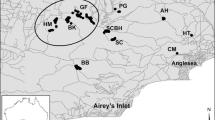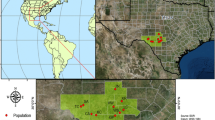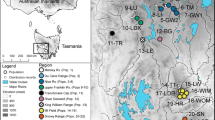Abstract
Various factors influence patterns of genetic diversity within and between populations that are important considerations for plant conservation. Both clonality and population genetic differentiation are key factors informing conservation actions, especially for rare species. Banksia mimica is a rare species that occurs in three disjunct locations in the biodiversity hotspot of the southwest Australian Floristic Region of Western Australia. Extant populations are suspected to have varying levels of clonality and high levels of genetic differentiation due to geographic disjunction. A genetic analysis was undertaken in order to confirm clonal reproduction and obtain initial estimates of genotypic diversity, and to assess genetic diversity within, and genetic structure among, populations. Genotypic richness ranged from 0.210 to 1.00 supporting observations in the field of variable degrees of clonal growth. The most clonal populations showed genetic signals of greater levels of observed heterozygosity than expected heterozygosity and negative FIS values that were not present in other populations of B. mimica or populations of the nonclonal sister taxon B. vestita. There was strong genetic structure with high genetic divergence among geographically disjunct population groups (global FST = 0.392, DST = 0.475), as is often found within the Australian flora. Genetic differentiation among disjunct populations located on the Whicher Scarp and more northern populations approached, or was greater than, that between Whicher populations and populations of the sister taxa B. vestita. This result is consistent with several other species that show genetic differentiation in disjunct populations located on the Whicher Scarp geomorphological formation. Results suggest a reassessment of the taxonomy and identification of evolutionary significant units for populations of B. mimica would support effective conservation management of this species.




Similar content being viewed by others
Data availability
The data sets generated during and/or anlaysed during the current study are available in the Dryad Digital Repository (doi available on publication).
References
ABRS, CSIRO (1999) Flora of Australia. ABRS/CSIRO, Melbourne
Allendorf FW, Luikart G, Aitken S (2013) Conservation and the genetics of populations, 2nd edn. Wiley-Blackwell, West-Sussex
Arnaud-Haond S, Belkhir K (2007) GENCLONE: a computer program to analyse geneotypic data, test for clonality and describe spatial clonal organisation. Mol Ecol Notes 7:15–17
Arnaud-Haond S, Alberto F, Teixeira S, Procaccini G, Serrão EA, Duarte CM (2005) Assessing genetic diversity in clonal organisms: low diversity or low resolution? Combining power and cost efficiency in selecting markers. J Heredity 96(4):434–440
Arnaud-Haond S, Duarte C, Alberto F, Serrao A (2007) Standardising methods to address clonality in population studies. Mol Ecol 16:5115–5139
Balloux F, Lehmann L, de Meeus T (2003) The population genetics of clonal and partially clonal diploids. Genetics 164:1635–1644
Bengtsson B (2003) Genetic variation in organisms with sexual and asexual reproduction. J Evol Biol 16:189–199
Bickford D, Lohram D, Sodhi N, Ng P, Meier R, Winker K, Ingham K, Das I (2007) Cryptic species as a window on diversity and conservation. Trends Ecol Evol 22:148–155
Birky C (1996) Heterozygosity, heteromorphy and phylogenetic trees in asexual eukaryotes. Genetics 144:427–437
Bradbury D, Grayling P, Macdonald B, Hankinson M, Byrne M (2015) Clonality, interspecific hybridisation and inbreeding in a rare mallee eucalypt, Eucalyptus absita (Myrtaceae), and implications for conservation. Conserv Genet 17:193–205
Bradbury D, Binks R, Coates D, Byrne M (2019) Conservation genomics of range disjunction in a global biodiversity hotspot: a case study of Banksia biterax (Proteaceae) in southwestern Australia. Biol J Linn Soc 127:390–406
Broadhurst L, Breed M, Lowe AJ, Bragg J, Catullo R, Coates D, Encinas-Viso F, Gellie N, James E, Krauss S, Potts B, Rosetto M, Shepard M, Byrne M (2017) Genetic diversity and structure of the Australian flora. Divers Distrib 23:41–52
Brown A, Thomson-Dans C, Marchant N (1998) Western Australia's threatened flora. Department of Conservation and Land Management, Como, Western Australia
Bruvo R, Michiels N, D”souza T, Schulenberg H (2004) A simple method for the calculation of microsatellite genotype distances irrespective of ploidy level. Mol Ecol 13:2101–2106
Burne HM, Yates C, Ladd P (2003) Comparative population structure and reproductive biology of the critically endangered shrub Grevillea althoferorum and two closely related more common congeners. Biol Conserv 114:53–65
Byrne M (2007) Phylogeography provides an evolutionary context for the conservation of a diverse and ancient flora. Aust J Bot 55:316–325
Byrne M, Hines B (2004) Phylogeographical analysis of cpDNA variation in Eucalyptus loxophleba (Myrtaceae). Aust J Bot 52:459–470
Byrne M, Hopper S (2008) Granite outcrops as ancient islands in old landscapes: evidence from the phylogeography and population genetics of Eucalyptus caesia (Myrtaceae) in Western Australia. Biol J Linn Soc Lond 93:177–188
Byrne M, Macdonald B, Coates D (1999) Divergence in the chloroplast genome and nuclear rDNA of the rare Western Australian plant, Lambertia orbifolia (Proteaceae). Mol Ecol 8:1789–1796
Byrne M, Macdonald B, Francki M (2001) Incorporation of sodium sulfite into extraction protocol minimizes degradation of Acacia DNA. Biotechniques 30:742–748
Byrne M, MacDonald B, Coates D (2002) Phylogeographical patterns in chloroplast DNA variation within the Acacia acuminata (Leguminoseae: Mimosiodeae) complex in Western Australia. J Evol Biol 15:576–587
Byrne M, MacDonald B, Brand J (2003a) Phylogeography and divergence in the chloroplast genome of Western Australian Sandalwood (Santalum spicatum). Heredity 91:389–395
Byrne M, MacDonald B, Broadhurst L, Brand J (2003b) Regional genetic differentiation in Western Australian sandalwood (Santalum spicatum) as revealed by nuclear RFLP analysis. Theor Appl Genet 107:1208–1214
Byrne M, Stone L, Millar MA (2011) Assessing genetic risk in revegetation. J Appl Ecol 48:1365–1373
Canty A, Ripley B (2020) Bootstrap R (S-Plus) Functions. R package version 1.3-25
Cardillo M, Paratt R (2013) Evolution of a hotspot genus: geographic variation in speciation and extinction rates in Banksia (Proteacea). BMC Evol Biol 13(1):155
Chapuis M-P, Estoup A (2007) Microsatellite null alleles and estimation of population differentiation. Mol Biol Evol 24:621–631
Coates D (1988) Genetic diversity and population genetic structure in the rare Chittering Grass Wattle, Acacia anomala Court. Aust J Bot 36:273–286
Coates DJ (2000) Defining conservation units in a rich and fragmented flora: implications for the management of genetic resources and evolutionary processes in south-west Australian plants. Aust J Bot 48:329–339
Coates DJ, Carstairs S, Hamley VL (2003) Evolutionary patterns and genetic structure in localized and widespread species in the Stylidium caricifolium complex (Stylidiaceae). Am J Bot 90:997–1008
Crandall K, Bininda-Edmonds O, Mace G, Wayne R (2000) Considering evolutionary processes in conservation biology. Trends Ecol Evol 15:290–295
Eckert C (2002) The loss of sex in clonal plants. Evol Ecol 15:501–520
Ellstrand NC, Ellam D (1993) Population genetic consequences of small population size: implications for plant conservation. Annu Rev Ecol Syst 24:217–242
Ellstrand NC, Roose ML (1987) Patterns of genotypic diversity in clonal plant species. Am J Bot 74:123–131
Excoffier L, Smouse P, Quattro J (1992) Analysis of molecular variance inferred from metric distances among DNA haplotypes: application to human mitochondrial DNA restriction data. Genetics 131:479–491
George A (1984) Dryandra mimica, a new species of Proteaceae from south-west Western Australia. Nuytsia 5:49–51
George A (1999) Dryandra. In: Orchard A, Thompson H, McCarthy P (eds) Flora of Australia 17B:251–363. ABRS and CSIRO, Canberra, pp 251–363
Hagan R, Dunne C, Keighery G, Steere C, Strelein G, Webb A, Whisson G (2011) Conservation significance and management options for the vegetation, floristic and other conservation values of the Whicher Scarp. In: DoEa C (ed) Sustainable forest management series. Department of Environment and Conservation, Perth
Halkett F, Plantegenest M, Prunier-Leterme N, Mieuzet L, Delmotte F, Sinmon J (2005) Admixed sexual and facultatively asexual aphid lineages at mating sites. Molecular Ecoloogy 14:325–336
He T, Lamont BB, Downes K (2011) Bankisa born to burn. New Phytol 191:184–196
Honnay O, Bossuyt B (2005) Prolonged clonal growth: escape route or route to extinction? Oikos 108:427–432
Honnay O, Jacquemyn J (2008) A meta-analysis of the relation between mating system, growth form and genotypic diversity in clonal plant species. Evol Ecol 22:299–312
Hopper SD (1979) Biogeographical aspects of speciation in the southwest Australian flora. Annu Rev Syst Ecol 10:399–422
Hopper S, Gioia P (2004) The southwest Australian floristic region: evolution and conservation of a global hotspot of biodiversity. Annu Rev Ecol Evol Syst 35:623–650
Hopper S, Harvey M, Chappill J, Main A, Main B (1996) The Western Australian biota as Gondwanan heritage—a review. In: Hopper S, Chappill J, Harvey M, George A (eds) Gondwanan heritage - past present and future of the Western Australian biota. Surrey Beaty and Sons, Chipping Norton, pp 1–46
James S (2000) Genetic systems in the south-west flora: implications for conservation strategies for Australian plant species. Aust J Bot 48:341–347
Jombart T (2008) adegenet: a R package for the multivariate analysis of genetic markers. Bioinformatics 24:1403–1405
Jombart T, Devillard S, Balloux F (2010) Discriminant analysis of principal components: a new method for the analysis of genetically structured populations. BMC Genetics 11(1):94
Jost L, Archer F, Flanagan S, Gaggiotti O, Hoban S, Latch E (2018) Differentiation measures for conservation genetics. Evol Appl 11:1139–1148
Kalinowski S (2005) HP-RARE 1.0: a computer program for performing rarefaction on measures of allelic richness. Mol Ecol Notes 5:187–189
Kamvar Z, Tabima J, Grűnwald N (2014) Poppr: an R package for genetic analysis of populations with clonal, partially clonal, and/or sexual reproduction. PeerJ 2:e281
Kamvar Z, Books J, Grűnwald N (2015) Novel R tools for analysis of genome-wide population genetic data with emphasis on clonality. Frontiers in Genetics 6:208
Keenan K, McGinnity P, Crozier T, Prodöhl P (2013) diveRsity: An R package for the estimation and exploration of population genetis parameters and their associated errors. Methods Ecol Evol 4:782–788
Keighery B, Keighery G, Webb A, Longman V, Griffin AR (2008) A floristic survey of the Whicher Scarp. Perth, Department of Environment and Conservation, p 208
Kelly A, Monks L, Hickman E, Coates D (1999) Conservation biology and management of three endangered Dryandra specie: Dryandra ionthocarpa, D. mimica and D. montana. Department of Conservation and Land Management, Perth
Kennington W, James S (1997a) The effect of small population size on the mating system of a rare clonal mallee, Eucalyptus argutifolia. Heredity 78:252–260
Kennington WJ, James SH (1997b) Contrasting patterns of clonality in two closely related mallee species from Western Australia Eucalyptus argutifolia and E. obtusiflora (Myrtaceae). Aust J Bot 45:679–689
Kennington WJ, Waycott M, James S (1996) DNA fingerprinting supports notions of clonality in a rare mallee, Eucalyptus argutifolia. Mol Ecol 5:693–696
Llorens T, MacDonald B, McArthur S, Coates D, Byrne M (2015) Disjunct, highly divergent genetic lineages within two rare Eremophila (Scrophulariaceae: Myoporeae) species in a biodiversity hotspot: implications for taxonomy and conservation. Bot J Linn Soc 177:96–111
Lloyd D (1980) Benefits and handicaps of sexual reproduction. Evol Biol 13:69–111
Mark WM, Meselson M (2000) Evidence for the evolution of bdelloid rotifers without sexual reproduction or genetic exchange. Science 288:1211–1215
Mark WM, Meselson M (2001) Rates of nucleotide substitution in sexual and anciently asexual rotifers. Proc Natl Acad Sci USA 98:6720–6724
Meirmans P, Hedrick P (2011) Assessing population structure: FST and related measures. Mol Ecol Resour 11:5–18
Meirmans P, Van Tienderen P (2004) GENOTYPE and GENODIVE: two programs for the analysis of genetic diversity of asexual organisms. Mol Ecol Notes 4:792–794
Meney KA, Pate JS, Dixon KW (1990) Phenology of growth and resource deployment in Alexgeorgea nitens (Nees) Johnson & Briggs (Restionaceae), a clonal species from south-western Western Australia. Aust J Bot 38:543–557
Myers N, Mittermeier RA, Mittermeier CG, da Fonseca GAB, Kent J (2000) Biodiversity hotspots for conservation priorities. Nature 403(6772):853–858
Millar M, Byrne M (2008) Characterisation of polymorphic microsatellite DNA markers in Banksia nivea, formerly Dryandra nivea. Mol Ecol Resour 8:1393–1394
Millar M, Byrne M (2013) Cryptic divergent lineages of Pultenaea pauciflora M.B. Scott (Fabacaea: Mirbelieae) exhibit different evolutionary history. Biol J Linn Soc Lond 108:871–881
Millar M, Byrne M, Coates D (2010) The maintenance of disparate levels of clonality, genetic diversity and genetic differentiation in disjunct subspecies of the rare Banksia ionthocarpa. Mol Ecol 19:4217–4227
Moritz C (1994) Defining 'evolutionary significant units' for conservation. Trends Ecol Evol 9:373–375
Moritz C (2002) Strategies to protect biological diversity and the evolutionary processes that sustain it. Syst Biol 51:238–254
Patrick S, Brown A (2001) Western Australian Wildlife Management Program No. 28. Declared rare and poorly known flora in the Moora district. Department of Conservation and Land Management, Perth
Pritchard J, Stephens M, Donnely P (2000) Inference of population structure using multilocus genotype data. Genetics 155:945–959
R Core Team (2019) R: a language and environment for statistical computing. Foundation for Statistical Computing, Vienna, Austria
Raymond M, Rousset F (1995) GENEPOP (version 3.4): population genetics software for exact tests and ecumenicism. J Hered 86:248–249
Richards A (1986) Plant breeding systems. George Allen and Unwin, London, UK
Rossetto M, Jezierski G, Hopper SD, Dixon K (1999) Conservation genetics and clonality in two critically endangered eucalypts from the highly endemic south-western Australian flora. Biol Conserv 88:321–331
Ryder O (1986) Species conservation and systematics: the dilemma of subspecies. Trends Ecol Evol 1:9–10
Sampson J, Byrne M (2016) Assessing genetic structure in a rare clonal eucalypt as a basis for augementation and introduction translocations. Conserv Genet 17:293–304
Sampson J, Hankinson M, McArthur S, Tapper S, Langley M, Gibson N, Yates C, Byrne M (2015) Long-term 'islands' in the landscape: low gene flow, effective population size and genetic divergence in the srub Hakea oldfieldii (Proteaceae). Bot J Linn Soc 179:319–334
Silvertown J (2008) The evolutionary maintenance of sexual reproduction: evidence from the ecological distribution of asexual reproduction in clonal plants. International Journal of Plant Science 169:157–168
Vallejo-Marin M, Brien OH (2007) Correlated evolution of self-incompatibility and clonal reproduction in Solanum (Solanaceae). New Phytol 173:415–421
Vallejo-Marin M, Dorken M, Barrett S (2010) The ecological and evolutionary consequences of clonality for plant mating. Annu Rev Ecol Evol Syst 41:193–213
van Oosterhout C, Hiutchinson W, Wills D, Shipley P (2004) MICRO-CHECKER: software for identifying and correcting genotyping errors in microsatellite data. Mol Ecol Notes 4:535–538
Walker E, Byrne M, Macdonald B, Nicolle D, McComb JA (2009) Clonality and hybrid origin of the rare Eucalyptus bennettiae (Myrtaceae) in Western Australia. Aust J Bot 57:180–188
Warnes G, Bolker B, Bonebakker L, Gentleman R, Huber W, Liaw A, Lumley T, Maechler M, Magnussin A, Moeller S, Schwartz MK, Venables E, Galili T (2016) gplots: various R programming tools for plotting data
Widen J, Sears C, Baack E, Ottho S (1994) Genotypic diversity, molecular markers and spatial distribution of genets in clonal plants: a literature survey. Folia Geobotanica Phytotaxon 29:245–263
Williams K, Horan A, Wood S, Webb A (2001) Declared rare and poorly known flora in the central forest region. Part 2. Western Australian Wildlife Management Program No 33. Department of Conservation and Land Management, Perth
Author information
Authors and Affiliations
Contributions
MB conceived the research; MAM and MB designed the research and performed the fieldwork; MAM performed the laboratory work, analysed the data and wrote the first draft of the manuscript. All authors commented on previous versions of the manuscript and read and approved the final manuscript.
Corresponding author
Ethics declarations
Conflict of interest
The authors declare no conflict of interest.
Additional information
Publisher's Note
Springer Nature remains neutral with regard to jurisdictional claims in published maps and institutional affiliations.
Electronic supplementary material
Below is the link to the electronic supplementary material.
Rights and permissions
About this article
Cite this article
Millar, M.A., Byrne, M. Variable clonality and genetic structure among disjunct populations of Banksia mimica. Conserv Genet 21, 803–818 (2020). https://doi.org/10.1007/s10592-020-01288-0
Received:
Accepted:
Published:
Issue Date:
DOI: https://doi.org/10.1007/s10592-020-01288-0




